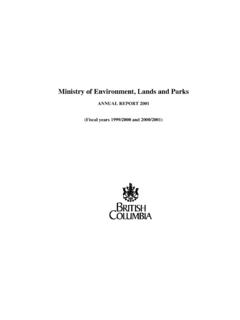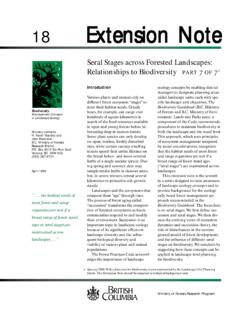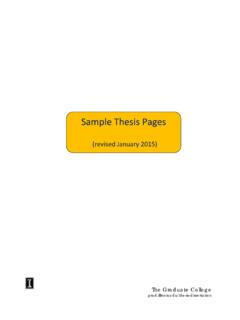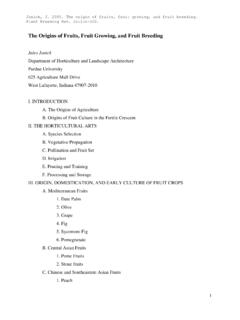Transcription of Techniques and Procedures for Collecting, Preserving ...
1 W O R K I N G P A P E R. Techniques and Procedures for Collecting, Preserving , processing , and Storing Botanical Specimens . Province of British Columbia Ministry of Forests Research Program The use of trade, firm, or corporation names in this publication is for the information and convenience of the reader. Such use does not constitute an official endorsement or approval by the Government of British Columbia of any product or service to the exclusion of any others that may also be suitable. Contents of this report are presented for discussion purposes only.
2 Citation: British Columbia Ministry of Forests.. Techniques and Procedures for collecting, Preserving , processing , and storing botanical specimens. Res. Br., Min. For., Victoria, Work. Pap. / . Prepared for Ministry of Forests Research Branch Bastion Square Victoria, BC V W E . Copies of this report may be obtained, depending upon supply, from: Ministry of Forests Forestry Division Services Branch Production Resources Broad Street Victoria, BC V W E . Province of British Columbia The contents of this report may not be cited in whole or in part without the approval of the Director of Research, Ministry of Forests, Victoria, BC.
3 SEQ 3466 JOB WP18-000-025 PAGE-0003 FRONT MATTER. REVISED 06 MAR00 AT 14:42 BY BC DEPTH: PICAS WIDTH 41 PICAS. COLOR LEVEL 1. ACKNOWLEDGEMENTS. This manual represents the combined efforts of many people who contributed their expertise: Gerry Allen, Gail Berg, Brenda Costanzo, George Douglas, Brian Egan, Trevor Goward, Joan Kerik, Olivia Lee, Del Meidinger, Alison Nicholson, John Pinder-Moss, Gloria Ruyle, Mike Ryan, and Pat Warrington. Fran Aitkens edited the manuscript, Beth Collins did the typesetting, and Donald Gunn provided the illustrations.
4 Iii SEQ 3468 JOB WP18-000-025 PAGE-0005 FRONT MATTER. REVISED 06 MAR00 AT 14:42 BY BC DEPTH: PICAS WIDTH 41 PICAS. COLOR LEVEL 1. CONTENTS. Acknowledgements .. iii Introduction .. PART I: VASCULAR PLANTS.. Collection of Specimens .. Gathering the Specimens .. Recording the Data .. Preservation of Specimens .. Pressing .. Drying .. processing of Specimens .. Identification .. Label Preparation .. Mounting .. Accessioning (Cataloguing) .. Storage of Specimens .. Organization .. Handling .. Maintenance .. PART II: BRYOPHYTES AND LICHENS.
5 Collection of Specimens .. Gathering the Specimens .. Recording the Data .. Preservation of Specimens .. Basic Techniques .. processing of Specimens .. Identification .. Mounting .. APPENDICES. Suggested equipment list .. Product and equipment suppliers .. National and university herbaria .. Regional herbaria .. Glossary of terms .. Useful botanical publications .. v SEQ 3469 JOB WP18-000-025 PAGE-0006 FRONT MATTER. REVISED 06 MAR00 AT 14:42 BY BC DEPTH: PICAS WIDTH 41 PICAS. COLOR LEVEL 1. FIGURES. Botanical specimens mounted on standard herbarium sheets.
6 Sample page from a field notebook .. Method for determining the Universal Transverse Mercator reference (UTM) .. Plant press showing arrangement of parts .. Arrangement of specimens on flimsies .. Folding packets for bryophytes and lichens or for seeds/fragments .. Portable light bulb plant dryer/storage box .. Tying the herbarium knot .. Standard label for a herbarium sheet .. Arrangement of dried specimens on herbarium sheets .. Placement of glue or linen straps across mounted specimens .. vi SEQ 3470 JOB WP18-001-031 PAGE-0001 INTRO.
7 REVISED 06 MAR00 AT 14:42 BY BC DEPTH: PICAS WIDTH 41 PICAS. COLOR LEVEL 1. INTRODUCTION. Botanical collections are essential to our understanding of British Columbia's flora and plant communities. A good-quality herbarium reference collection provides the following: a tool for plant identification;. a data source for research on the taxonomy and distribution of plant groups and for writing handbooks and floras;. an historical record of plant locations, and of a collector's contribution to the science of botany;. a repository for voucher specimens related to published scientific reports.
8 An educational resource for learning to recognize the plant species of an area; and accurate and permanent documentation of botanical information that adds credibility to data collected in vegetation surveys. This manual lists equipment and describes Techniques and Procedures for collecting, Preserving , processing , and storing plant specimens. Bryophytes (mosses, liverworts, and hornworts) and lichens require different collection and preservation Techniques , and are treated separately from vascular plants (seed plants, ferns, clubmosses and horsetails) in this report.
9 In the appendices you will find information to assist you in obtaining supplies, contacting herbaria, or locating reference texts for British Columbia flora. Note: Terms appearing in the glossary are initially set in bold face.. SEQ 3471 JOB WP18-001-031 PAGE-0002 INTRO. REVISED 06 MAR00 AT 14:42 BY BC DEPTH: PICAS WIDTH 41 PICAS. COLOR LEVEL 1. PART I: VASCULAR PLANTS. 1 COLLECTION OF SPECIMENS. Collection of botanical material involves two activities gathering the specimens and recording the information. Even if you have a relatively good knowledge of the local flora, you may not be able to accurately identify all plants in the field.
10 During vegetation sampling, collect repre- sentative specimens of all species that are important to meet your collec- tion needs (except for known rare and endangered specimens, which can be photographically recorded). These specimens will later be used to con- firm identification and provide a permanent record for future reference. Your collection may also represent a range extension or contribute to the knowledge of a plant's taxonomic or natural history. It may also show the plasticity'' or variations possible under different habitat conditions.








